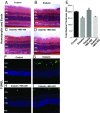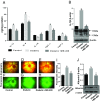Protective effects of agonists of growth hormone-releasing hormone (GHRH) in early experimental diabetic retinopathy
- PMID: 29180438
- PMCID: PMC5740669
- DOI: 10.1073/pnas.1718592114
Protective effects of agonists of growth hormone-releasing hormone (GHRH) in early experimental diabetic retinopathy
Abstract
The potential therapeutic effects of agonistic analogs of growth hormone-releasing hormone (GHRH) and their mechanism of action were investigated in diabetic retinopathy (DR). Streptozotocin-induced diabetic rats (STZ-rats) were treated with 15 μg/kg GHRH agonist, MR-409, or GHRH antagonist, MIA-602. At the end of treatment, morphological and biochemical analyses assessed the effects of these compounds on retinal neurovascular injury induced by hyperglycemia. The expression levels of GHRH and its receptor (GHRH-R) measured by qPCR and Western blotting were significantly down-regulated in retinas of STZ-rats and in human diabetic retinas (postmortem) compared with their respective controls. Treatment of STZ-rats with the GHRH agonist, MR-409, prevented retinal morphological alteration induced by hyperglycemia, particularly preserving survival of retinal ganglion cells. The reverse, using the GHRH antagonist, MIA-602, resulted in worsening of retinal morphology and a significant alteration of the outer retinal layer. Explaining these results, we have found that MR-409 exerted antioxidant and anti-inflammatory effects in retinas of the treated rats, as shown by up-regulation of NRF-2-dependent gene expression and down-regulation of proinflammatory cytokines and adhesion molecules. MR-409 also significantly down-regulated the expression of vascular endothelial growth factor while increasing that of pigment epithelium-derived factor in diabetic retinas. These effects correlated with decreased vascular permeability. In summary, our findings suggest a neurovascular protective effect of GHRH analogs during the early stage of diabetic retinopathy through their antioxidant and anti-inflammatory properties.
Keywords: GH; GHRH; GHRH-R; diabetic retinopathy; type 1 diabetes.
Copyright © 2017 the Author(s). Published by PNAS.
Conflict of interest statement
Conflict of interest statement: N.L.B. owns equity in Biscayne Pharmaceuticals. A.V.S. is a coinventor on the patent for GHRH agonist, assigned to the University of Miami and the Veterans Affairs Medical Center, Miami, FL. However, the investigation of the effects of GHRH agonist MR-409 was an academic endeavor without any commercial interests. The other authors declare no conflict of interest.
Figures




Similar articles
-
Agonist of growth hormone-releasing hormone enhances retinal ganglion cell protection induced by macrophages after optic nerve injury.Proc Natl Acad Sci U S A. 2021 Jul 13;118(28):e1920834118. doi: 10.1073/pnas.1920834118. Proc Natl Acad Sci U S A. 2021. PMID: 34244423 Free PMC article.
-
Antinflammatory, antioxidant, and behavioral effects induced by administration of growth hormone-releasing hormone analogs in mice.Sci Rep. 2020 Jan 20;10(1):732. doi: 10.1038/s41598-019-57292-z. Sci Rep. 2020. PMID: 31959947 Free PMC article.
-
Α-Melanocyte-Stimulating Hormone Protects Early Diabetic Retina from Blood-Retinal Barrier Breakdown and Vascular Leakage via MC4R.Cell Physiol Biochem. 2018;45(2):505-522. doi: 10.1159/000487029. Epub 2018 Jan 25. Cell Physiol Biochem. 2018. PMID: 29402864
-
A novel approach for the treatment of AML, through GHRH antagonism: MIA-602.Rev Endocr Metab Disord. 2025 Jun;26(3):483-491. doi: 10.1007/s11154-024-09917-6. Epub 2024 Oct 17. Rev Endocr Metab Disord. 2025. PMID: 39417961 Free PMC article. Review.
-
The development of growth hormone-releasing hormone analogs: Therapeutic advances in cancer, regenerative medicine, and metabolic disorders.Rev Endocr Metab Disord. 2025 Jun;26(3):385-396. doi: 10.1007/s11154-024-09929-2. Epub 2024 Nov 26. Rev Endocr Metab Disord. 2025. PMID: 39592529 Free PMC article. Review.
Cited by
-
Inactivation of Endothelial ADAM17 Reduces Retinal Ischemia-Reperfusion Induced Neuronal and Vascular Damage.Int J Mol Sci. 2020 Jul 29;21(15):5379. doi: 10.3390/ijms21155379. Int J Mol Sci. 2020. PMID: 32751103 Free PMC article.
-
Agonist of growth hormone-releasing hormone improves the disease features of spinal muscular atrophy mice.Proc Natl Acad Sci U S A. 2023 Jan 10;120(2):e2216814120. doi: 10.1073/pnas.2216814120. Epub 2023 Jan 5. Proc Natl Acad Sci U S A. 2023. PMID: 36603028 Free PMC article.
-
Protective Effects of Fucoxanthin Dampen Pathogen-Associated Molecular Pattern (PAMP) Lipopolysaccharide-Induced Inflammatory Action and Elevated Intraocular Pressure by Activating Nrf2 Signaling and Generating Reactive Oxygen Species.Antioxidants (Basel). 2021 Jul 7;10(7):1092. doi: 10.3390/antiox10071092. Antioxidants (Basel). 2021. PMID: 34356327 Free PMC article.
-
Growth hormone releasing hormone signaling promotes Th17 cell differentiation and autoimmune inflammation.Nat Commun. 2023 Jun 6;14(1):3298. doi: 10.1038/s41467-023-39023-1. Nat Commun. 2023. PMID: 37280225 Free PMC article.
-
Growth hormone-releasing hormone (GHRH) and its agonists inhibit hepatic and tumoral secretion of IGF-1.Oncotarget. 2018 Jun 19;9(47):28745-28756. doi: 10.18632/oncotarget.25676. eCollection 2018 Jun 19. Oncotarget. 2018. PMID: 29983893 Free PMC article.
References
-
- Sivaprasad S, Gupta B, Crosby-Nwaobi R, Evans J. Prevalence of diabetic retinopathy in various ethnic groups: A worldwide perspective. Surv Ophthalmol. 2012;57:347–370. - PubMed
-
- Tan GS, Cheung N, Simó R, Cheung GC, Wong TY. Diabetic macular oedema. Lancet Diabetes Endocrinol. 2017;5:143–155. - PubMed
-
- Tolentino MS, Tolentino AJ, Tolentino MJ. Current and investigational drugs for the treatment of diabetic retinopathy. Expert Opin Investig Drugs. 2016;25:1011–1022. - PubMed
-
- Antonetti DA, Klein R, Gardner TW. Diabetic retinopathy. N Engl J Med. 2012;366:1227–1239. - PubMed
-
- Murray PG, Higham CE, Clayton PE. 60 years of neuroendocrinology: The hypothalamo-GH axis: The past 60 years. J Endocrinol. 2015;226:T123–T140. - PubMed
Publication types
MeSH terms
Substances
Grants and funding
LinkOut - more resources
Full Text Sources
Other Literature Sources
Medical

